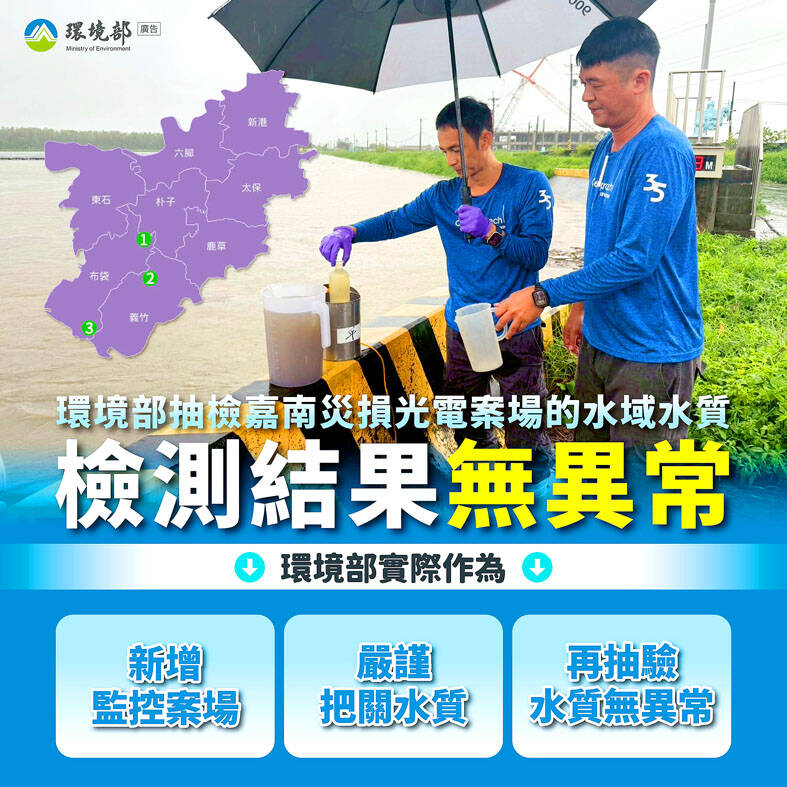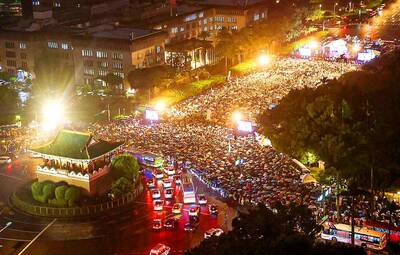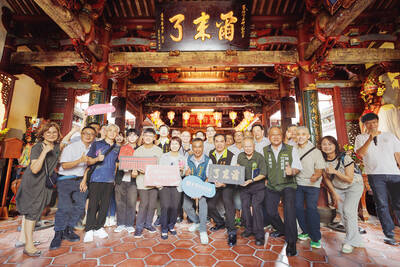The Ministry of Environment (MOENV) yesterday said that water quality testing on Monday found no evidence of heavy metal pollution from Typhoon Danas-damaged solar panels in Chiayi County.
The tropical storm on July 7 made landfall to cause heavy economic losses in southern and central regions of Taiwan, including damaging or destroying 145,000 photovoltaic panel units.
Central and local environment officials conducted the most recent tests in multiple locations in Chiayi City and Chiayi County’s hard-struck Budai Township (布袋) for cadmium, lead, hexavalent chromium, zinc, manganese, silver and nickel, the ministry said.

Photo courtesy of the Ministry of Environment
Samples were also tested for indium, molybdenum, barium and antimony, elements not included in previous tests, it said.
On the day of the tests, rains from southwestern airflows caused surface overruns and unsettled the silt, resulting in muddiness in the county’s water, the ministry said.
The tests showed no sign of pollution by the former group of six substances, while the level of the latter group of four substances were comparable to the baseline from before the typhoon, it said.
They indicated that water quality in the county continues to meet government safety and potability standards, the ministry said.
Damaged solar energy modules did not pollute the county’s waters at least in the short term and any pollutant would have drained into the retention pond of fish farms where they were installed, the ministry said.
Ministry officials continue to monitor water quality every two weeks, it said.
Solar panels are mostly made of aluminum, glass, waterproof membrane and power generation components, the ministry said, adding that 92 percent of decommissioned modules are to be recycled, not buried or incinerated.
The cleanup of broken photovoltaic equipment, as well as decontamination and mosquito prevention measures, is being carried out, partly by the private-sector entities that own the solar panels, it said.

The Central Weather Administration (CWA) today issued a "tsunami watch" alert after a magnitude 8.7 earthquake struck off the Kamchatka Peninsula in northeastern Russia earlier in the morning. The quake struck off the east coast of the Kamchatka Peninsula at 7:25am (Taiwan time) at a depth of about 19km, the CWA said, citing figures from the Pacific Tsunami Warning Center. The CWA's Seismological Center said preliminary assessments indicate that a tsunami could reach Taiwan's coastal areas by 1:18pm today. The CWA urged residents along the coast to stay alert and take necessary precautions as waves as high as 1m could hit the southeastern

FINAL COUNTDOWN: About 50,000 attended a pro-recall rally yesterday, while the KMT and the TPP plan to rally against the recall votes today Democracy activists, together with arts and education representatives, yesterday organized a motorcade, while thousands gathered on Ketagalan Boulevard in Taipei in the evening in support of tomorrow’s recall votes. Recall votes for 24 Chinese Nationalist Party (KMT) lawmakers and suspended Hsinchu City mayor Ann Kao (高虹安) are to be held tomorrow, while recall votes for seven other KMT lawmakers are scheduled for Aug. 23. The afternoon motorcade was led by the Spring Breeze Culture and Arts Foundation, the Tyzen Hsiao Foundation and the Friends of Lee Teng-hui Association, and was joined by delegates from the Taiwan Statebuilding Party and the Taiwan Solidarity

Instead of threatening tariffs on Taiwan-made chips, the US should try to reinforce cooperation with Taiwan on semiconductor development to take on challenges from the People’s Republic of China (PRC), a Taiwanese think tank said. The administration of US President Donald Trump has threatened to impose across-the-board import duties of 32 percent on Taiwan-made goods and levy a separate tariff on semiconductors, which Taiwan is hoping to avoid. The Research Institute for Democracy, Society, and Emerging Technology (DSET), a National Science and Technology Council think tank, said that US efforts should focus on containing China’s semiconductor rise rather than impairing Taiwan. “Without

The National Museum of Taiwan Literature is next month to hold an exhibition in Osaka, Japan, showcasing the rich and unique history of Taiwanese folklore and literature. The exhibition, which is to run from Aug. 10 to Aug. 20 at the city’s Central Public Hall, is part of the “We Taiwan” at Expo 2025 series, highlighting Taiwan’s cultural ties with the international community, National Museum of Taiwan Literature director Chen Ying-fang (陳瑩芳) said. Folklore and literature, among Taiwan’s richest cultural heritages, naturally deserve a central place in the global dialogue, Chen said. Taiwan’s folklore would be immediately apparent at the entrance of the